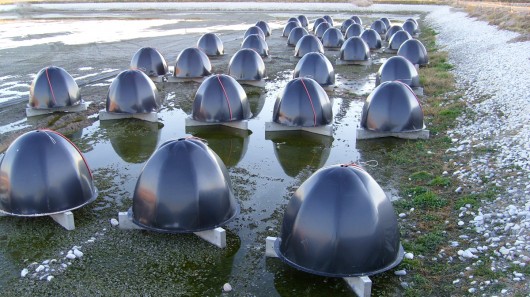Poo isn’t something generally talked about in polite company but like it or not, all of that human waste has to go somewhere.
In smaller rural communities, it usually goes to wastewater lagoon systems; the alternative is mechanical treatment plants which process waste far more quickly but are expensive, labor intensive and often use chemicals. Enter the “Poo-Gloo,” or Bio-Dome as it is officially known – an igloo-shaped device that can reportedly clean up sewage as effectively, but far more cheaply, than its mechanical counterparts. The Poo-Gloo, developed by Wastewater Compliance Systems, Inc., uses a combination of air, dark environment and large surface area to encourage the growth of a bacterial biofilm which consumes the wastewater pollutants. It is claimed that Poo-Gloos can treat pollutants just as quickly as mechanical plants while operating at a fraction of the cost – hundreds of dollars a month rather than thousands – and can be retrofitted to existing lagoon systems.
The Poo-Gloos work in clusters, with two dozen or more arranged in rows fully submerged at the bottom of the lagoon. Each Poo-Gloo consists of four concentrically nested plastic domes filled with plastic packing to provide a large surface area for bacterial growth. Rings of bubble-release tubes sit at the base of every Poo-Gloo and bubble air up through the cavities between domes. The air exits a hole in the top of each dome. As air moves through the dome, it draws water from the bottom of the lagoon up through the dome and out the top.
Individual Poo-Gloos create 2,800 square feet (260 square meters) of surface area for bacterial growth while taking up just 28 square feet (2.6 square meters) of space. In comparison with labor-intensive mechanical plants, Poo-Gloos require little maintenance. They use the same amount of electricity as a 75-watt bulb and can even be powered with solar or wind energy systems, further reducing the cost.
Taylor Reynolds, director of sales for Wastewater Compliance Systems says that most of the projects he quotes are between US$150,000 and $500,000, a far more palatable option for an average municipality than the $4 million to $10 million they are quoted for a mechanical plant.
A pilot study to evaluate Poo-Gloo performance at different water temperatures, levels of aeration, sewage volumes and concentrations yielded impressive results:










